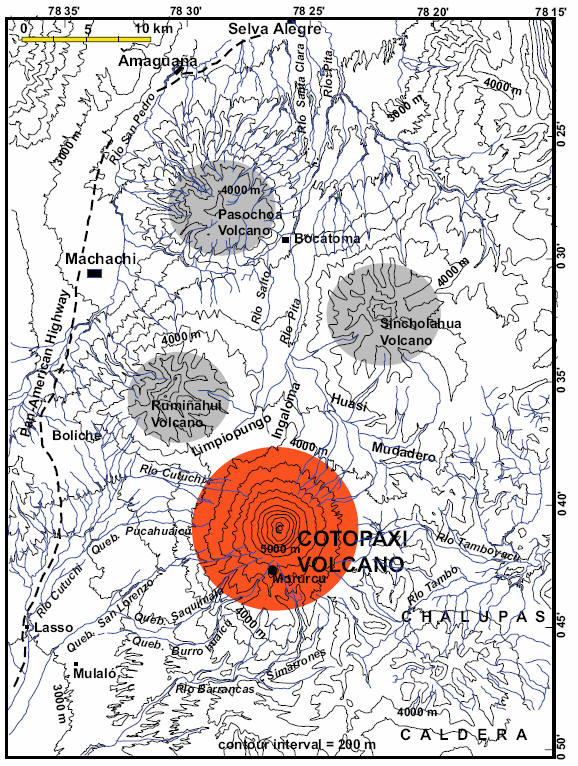|
Risk that
cotopaxi poses to the local population and economy
Cotopaxi may be a
beautiful volcano, with its symmetrical shape and
snow-capped summit, but its potential for destruction is
great. While there are relatively few people living within the
immediate vicinity of Cotopaxi, the possibility of a plinian-style eruption with large lahars and pyroclastic
flows and surges makes it a very real threat. Ancient as
well as relatively recent lahar fields and pyroclastic
flow deposits dominate the landscape surrounding this
beautiful mountain, and there is little telling exactly when
it will erupt again.

A topographic map of Cotopaxi Volcano and the surrounding landscape.18 Note the town of Mulalo to the southwest and Bocatoma to
the north, both of which are in the path that a lahar is likely to take. Also note Machachi to the northwest, a town that would be drastically affected by ash fall.
This town's economy relies heavily on a bottled water that is produced from its streams and sold nationally, and any ash fall in this region would drastically affect
the water supply and thus the town's economy.23
Cotopaxi Volcano in relation to Quito and other major towns and cities.19
It's clear from these maps that Cotopaxi poses a major threat to its surrounding towns. For example, the likely path
that any pyroclastic flows or surges would take does cover Mulalo, a town just to the southwest of its flanks (see the hazard maps page).
Furthermore, ash fall could easily cover numerous towns in the area, most of whose economies rely on natural commodities heavily.23
Ash is notorious for polluting water supplies,killing crops and starving livestock.
Still the greatest threat is from lahars, which, with numerous rivers leading from Cotopaxi to towns and cities in all directions, is a
disaster waiting to happen (see the 1877 lahars page). The Geophysical Institute in Ecuador estimates that about 100,000 people
would be in danger if lahars of the magnitude which we have seen from Cotopaxi were to occur again.24
In order to mitigate these risks, I suggest the following:
1) Further education of the people living within the danger zones of lahars, pyroclastic flows and ash fall, respectively.
2) Purchasing of equipment, such as brooms and shovels, to help people deal with ash fall and avoid roof collapse.
3) The Geophysical Institute's continued extensive monitoring of the volcano.
4) The development of a lahar drill for towns that could be affected by a lahar. By this I mean a plan to get all towns people away
from danger as quickly as possible, about which they are informed and tested (like a fire drill, only on a larger scale).
|